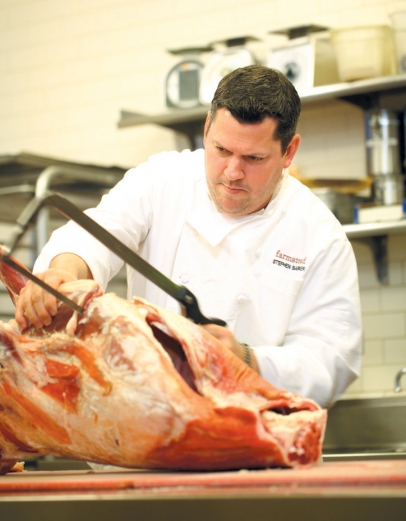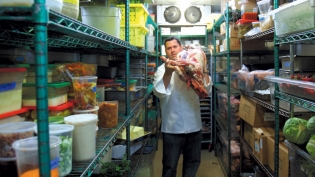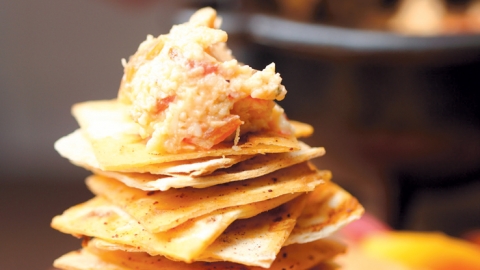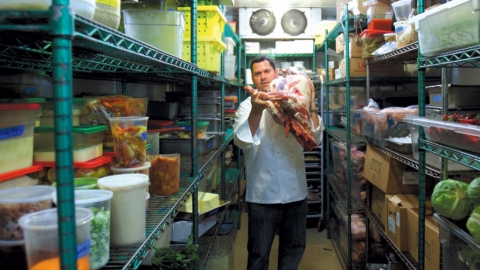Stephen Barber, Executive Chef of Farmstead at Long Meadow Ranch in St. Helena
Stephen Barber grew up in an area of Kentucky where hams hung from the ceiling of every grocery store. During his childhood, smoke wafted out of so many barns, Barber thought the barns were on fire. Country ham, cured and smoked, seeped into his bones.
“With the family, I was always the guy at the grill,” he says. Barber, who went looking for a restaurant job while in college, knocked at the back door of a culinary epicenter for Southern cooking: City Grocery in Oxford, Mississippi, where John Currence, a New Orleans native, was elevating Southern food into a fine-dining experience with a national following.
“I went back three or four times, and it paid off,” says Barber, who began his career there a few weeks later. “I learned all the basics from John.” [Editor’s note: For more on Chef John Currence, including his new cookbook, Pickles, Pigs & Whiskey, listen to our Editor’s interview with John at EdibleRadio.com.]
Barber went on to Miami and the proving ground of Norman van Aken’s Bambu as chef de cuisine.
“I read everything—Fernand Point, Larousse, Pepin—cover to cover.”
He also learned he could keep up with the guys coming out of culinary school. It was at Bambu that Barber first met restaurateur Gene Tartaglia.
“He invited me to California for a test run. I loved it so much, I decided to move here,” Barber says. Barber became executive chef at Tartaglia’s Mecca in 2002. A few years on, he opened Napa’s BarBersQ with Tartaglia, bringing his love of Memphis-style barbecue to the wine country.
As executive chef at Farmstead at Longmeadow Ranch, flavors from Barber’s youth and his Miami years season the ingredients pinched, snipped and pulled from the ranch’s 15-acre garden, or raised in the ranch’s barns, to create the dishes served at the restaurant.
“I draw on all of my experiences and influences,” Barber says, but at heart he remains a Southerner. “If a Southerner walks in [to Farmstead] and sits down, he should know the chef is Southern.”
Dishes like Edwards’ “Surryano” 2-year-aged country ham (from Surry, Virginia), St. Louis ribs with green apple coleslaw and wood grilled pork chop with jalapeno grits showcase Southern flavors, but clearly incorporate Barber’s—and the Ranch’s—commitment to sustainable land stewardship, humanely raised and slaughtered livestock and heritage breed conservation.
Every Wednesday, Farmstead offers a “California Creole” menu, dishes that mash up the flavors and ingredients of California and the South. Trout Pontchartrain, named for the famous Louisiana lake, features stone-ground grits—milled in Northern California.
Even the bourbon Barber makes in a 10-gallon copper still named Bessie includes organic corn. “I do a different mash every year,” he says. This year, it’s 52% corn, 10% wheat, rye and barley.
California bourbon from a Kentuckian? Surely that is best enjoyed with some of Barber’s barbecued ribs.
Where are you from?
Madisonville, Kentucky
At what age did you begin cooking?
I started working in a professional kitchen at 19
From whom did you learn to cook?
Chef John Currence in Oxford, Mississippi
Is there one dish (or ingredient) that defines the place you grew up?
Country ham. Smoke-filled barns near Cadiz, Kentucky. I thought the barns were on fire when I was young.
What is your first food memory?
Soft-serve ice cream at Dairy Queen, or maybe it was those yeast rolls drenched in butter that I ate by the half dozen
Favorite food memory?
First bite of a slow-smoked pulled pork sandwich at a little barbecue joint in Dawson Springs, Kentucky. They also served root beer in a frozen mug with crushed ice. I thought this was as good as it gets.
What is the first dish that you remember cooking by yourself, or mostly by yourself ?
Monkey bread
When did you first leave the South, and what/who was it that brought you out?
I left Oxford, Mississippi, around 1996, for Miami, Florida. [Editor’s note: Many in the South do not consider Miami to be a “Southern” city, even though it is, geographically speaking. Clearly, Barber is in this camp.)
Southern ingredients you can’t live without?
Bourbon or pecans
Southern food you miss the most?
Fried pies
Setting in which you most enjoyed that food?
Driving country roads. Kinda sounds like a country song. . .
Favorite Southern dish?
Shrimp and grits
How often do you have that food now, and do you cook it for yourself or have it when you dine out?
Couple times a year. I don’t cook it for myself, I only eat this one out. This dish is classic, everyone has their own take on it, so it’s interesting to see different interpretations.
Southern food you wish would never be served again?
Is congealed salad Southern?
How do you incorporate Northern California and/or international ingredients into Southern dishes, or is it vice versa?
It’s pretty easy at Farmstead. We have the most awesome smoker that any chef could wish to have and a live-fire outdoor kitchen where you could see a whole spring lamb or a whole pig slow-cooking over cherry wood. I can go on about this forever. On Wednesdays we feature “California Creole” dishes. Our Trout Pontchartrain is a good example: trout from Passmore Ranch in Sloughhouse, California, with bay shrimp, Dungeness crab and bearnaise sauce.
I wanted grits, so I asked a young lady at the Napa farmers’ market years ago if she would consider milling grits. She agreed, and thousands of pounds later, she continues to mill grits for me and many other chefs.
Do you think your Southern heritage influenced your love and appreciation of food?
Absolutely. The food traditions of the South are so rich. As I get further into my career, I look back closer and closer at history. I want to be able to tell a story through the food. The perfect cornbread, biscuit, gumbo, etc.
I have always felt that the work of a chef is a very personal one. You are creating something that people are putting into their body. If you think about it, that’s a heck of a responsibility.
Isn’t sitting down to share a meal the highlight of most people’s day? It’s what we look forward to. Spending time with family and friends, catching up, sharing great food and drink. It’s always worth the effort.
We have embraced family-style dining with our long tables at Farmstead. Parties of 10 or more are always served family style.
Favorite libation?
Bourbon—Maker’s [Mark] or Buffalo Trace. Sometimes my own. Not sure I should share that. Pappy [Van Winkle] when I treat myself. Manhattan, Old Fashioned, rocks or with a splash of ginger ale.
Favorite Southern-based band and/or song?
I think I would have to break this into genres and phases: the Allman Brothers to Southern Culture on the Skids to Elvis Presley to blues great Junior Kimbrough
Pie or cake?
Pie—lemon meringue or chocolate. These were the pies my grandmother used to make for any family gathering. My father and uncle had a little ongoing battle. Whoever arrived from out of town first got first crack at the lemon pie. On several occasions, I can recall the entire pie being consumed before the other arrived.
I’m also quite fond of any type of fried pie. These are the half-moon hand-sized pies that you pick up at gas stations and such. Peach, apple, cherry. They are all good!
Stephen Barber grew up in an area of Kentucky where hams hung from the ceiling of every grocery store. During his childhood, smoke wafted out of so many barns, Barber thought the barns were on fire. Country ham, cured and smoked, seeped into his bones.
“With the family, I was always the guy at the grill,” he says. Barber, who went looking for a restaurant job while in college, knocked at the back door of a culinary epicenter for Southern cooking: City Grocery in Oxford, Mississippi, where John Currence, a New Orleans native, was elevating Southern food into a fine-dining experience with a national following.
“I went back three or four times, and it paid off,” says Barber, who began his career there a few weeks later. “I learned all the basics from John.” [Editor’s note: For more on Chef John Currence, including his new cookbook, Pickles, Pigs & Whiskey, listen to our Editor’s interview with John at EdibleRadio.com.]
Barber went on to Miami and the proving ground of Norman van Aken’s Bambu as chef de cuisine.
“I read everything—Fernand Point, Larousse, Pepin—cover to cover.”
He also learned he could keep up with the guys coming out of culinary school. It was at Bambu that Barber first met restaurateur Gene Tartaglia.
“He invited me to California for a test run. I loved it so much, I decided to move here,” Barber says. Barber became executive chef at Tartaglia’s Mecca in 2002. A few years on, he opened Napa’s BarBersQ with Tartaglia, bringing his love of Memphis-style barbecue to the wine country.
As executive chef at Farmstead at Longmeadow Ranch, flavors from Barber’s youth and his Miami years season the ingredients pinched, snipped and pulled from the ranch’s 15-acre garden, or raised in the ranch’s barns, to create the dishes served at the restaurant.
“I draw on all of my experiences and influences,” Barber says, but at heart he remains a Southerner. “If a Southerner walks in [to Farmstead] and sits down, he should know the chef is Southern.”
Dishes like Edwards’ “Surryano” 2-year-aged country ham (from Surry, Virginia), St. Louis ribs with green apple coleslaw and wood grilled pork chop with jalapeno grits showcase Southern flavors, but clearly incorporate Barber’s—and the Ranch’s—commitment to sustainable land stewardship, humanely raised and slaughtered livestock and heritage breed conservation.
Every Wednesday, Farmstead offers a “California Creole” menu, dishes that mash up the flavors and ingredients of California and the South. Trout Pontchartrain, named for the famous Louisiana lake, features stone-ground grits—milled in Northern California.
Even the bourbon Barber makes in a 10-gallon copper still named Bessie includes organic corn. “I do a different mash every year,” he says. This year, it’s 52% corn, 10% wheat, rye and barley.
California bourbon from a Kentuckian? Surely that is best enjoyed with some of Barber’s barbecued ribs.









